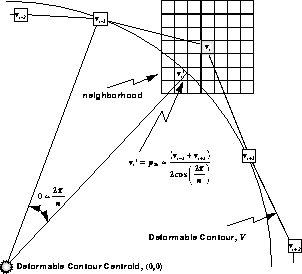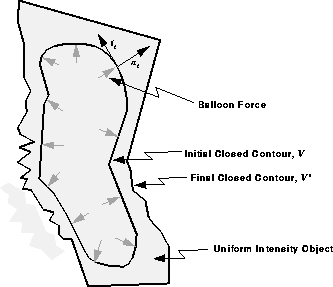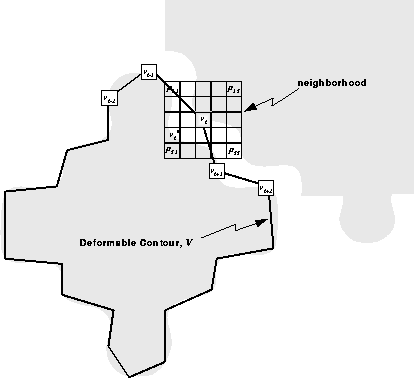
The internal energy function is intended to enforce a shape on the deformable contour and to maintain a constant distance between the points in the contour. Additional terms can be added to influence the motion of the contour.
The internal energy function used herein is defined as follows:

where  is the continuity energy that
enforces the shape of the contour and
is the continuity energy that
enforces the shape of the contour and  is a balloon
force that causes the contour to grow (balloon) or shrink.
is a balloon
force that causes the contour to grow (balloon) or shrink.  and
and
 provide the relative weighting of the energy terms.
provide the relative weighting of the energy terms.
In the absence of other influences, the continuity energy term coerces
an open deformable contour into a straight line and a closed
deformable contour into a circle. The formulation of the continuity
energy has been adopted from [29]. The energy term for each
element,  , in the matrix,
, in the matrix,  is defined
as follows:
is defined
as follows:
where  is the point in the image that corresponds
spatially to energy matrix element
is the point in the image that corresponds
spatially to energy matrix element  .
.
 for an open contour. In this case, the minimum energy
point is the point exactly half way between
for an open contour. In this case, the minimum energy
point is the point exactly half way between  and
and
 .
.
For the case of a closed contour,  is given a modulus of
is given a modulus of  .
Therefore,
.
Therefore,  .
.  is then defined as follows:
is then defined as follows:

Here, the point of minimum energy of  is pushed outward
so that
is pushed outward
so that  becomes a circle. This behavior is illustrated in
Figure 5.2.
becomes a circle. This behavior is illustrated in
Figure 5.2.

Figure 5.2: An example of the movement
of a point in an active contour due to continuity energy. The point,
 , is the location of minimum energy because it lies on the
circle connecting
, is the location of minimum energy because it lies on the
circle connecting  and
and  .
.
The normalization factor,  , in Equation 5.4 is
the average distance between points in
, in Equation 5.4 is
the average distance between points in  :
:

Magnitudes have been left squared to reduce the computational load.
The normalization is required to make  independent of
the size, location, and orientation of
independent of
the size, location, and orientation of  .
.
A balloon force can be used on a closed deformable contour to force the contour to expand (or shrink) in the absence of external influences. A contour initialized within a uniform image object will expand under the influence of a balloon force until it nears the object boundary (at which point the external energy function affects its motion). Figure 5.3 illustrates this behavior.

Figure 5.3: An example of the movement of
a deformable contour due to balloon energy. Because the object has
uniform intensity, a balloon force is required to push the contour
toward the object boundary.
Chalana et al. suggest an adaptive balloon force that varies inversely proportionally to the image gradient magnitude [10]. The adaptive balloon force is strong in homogeneous regions and weak near object boundaries, edges, and lines.
The energy term for each element,  , in the matrix,
, in the matrix,
 is expressed as a dot product:
is expressed as a dot product:

where  is the outward unit normal of
is the outward unit normal of  at point
at point  and
and  is the point in the neighborhood of
is the point in the neighborhood of  corresponding to entry
corresponding to entry  in the energy matrix.
Therefore, the balloon energy is smallest at points farthest from
in the energy matrix.
Therefore, the balloon energy is smallest at points farthest from
 in the direction of
in the direction of  .
.
 can be found by rotating the tangent vector,
can be found by rotating the tangent vector,  , by
, by
 .
.  is easily computed:
is easily computed:

So  is a unit vector normal to
is a unit vector normal to  .
.
Adaptive balloon forces are scaled by the image gradient magnitude at
point  . This can be considered part of the regularization
process and is discussed in Section 5.2.3.
. This can be considered part of the regularization
process and is discussed in Section 5.2.3.
The external energy function attracts the deformable contour to interesting features, such as object boundaries, in an image. Any energy expression that accomplishes this attraction can be considered for use.
Image gradient and intensity are obvious (and easy) characteristics to look at (another could be object size or shape). Therefore, the following external energy function is investigated:

where  is an expression that attracts the contour to
high or low intensity regions and
is an expression that attracts the contour to
high or low intensity regions and  is an energy term
that moves the contour towards edges. Again, the constants,
is an energy term
that moves the contour towards edges. Again, the constants,  and
and
 , are provided to adjust the relative weights of the terms.
, are provided to adjust the relative weights of the terms.
Each element in the intensity energy matrix,  is
assigned the intensity value of the corresponding image point in the
neighborhood of
is
assigned the intensity value of the corresponding image point in the
neighborhood of  :
:

Then, if  is positive, the contour is attracted to regions of low
intensity and vice-versa.
is positive, the contour is attracted to regions of low
intensity and vice-versa.
The image gradient energy function attracts the deformable contour to edges in the image. An energy expression proportional to the gradient magnitude will attract the contour to any edge:

When active contours are used to find object boundaries, an energy expression that discriminates between edges of adjacent objects is desirable. The key to such an expression is that the gradients at the edges of the objects have different directions. Further, the direction of the gradient at the object's edge should be similar to the direction of the unit normal of the contour. This situation is illustrated in Figure 5.4.

Figure 5.4: An example of the movement of
a deformable contour due to gradient energy. Because the gradient
direction at the edge of the object of interest is similar to the
outward unit normal direction of the contour, the active contour
algorithm moves the snake point from  to
to  even though the gradient magnitudes at both points are
similar.
even though the gradient magnitudes at both points are
similar.
The value for each element in the directional gradient energy matrix,
 , can therefore be defined by a dot product between
the unit normal of the deformable contour and the image gradient:
, can therefore be defined by a dot product between
the unit normal of the deformable contour and the image gradient:

where  is the unit normal of the contour at point
is the unit normal of the contour at point  as
defined in Section 5.2.1.
as
defined in Section 5.2.1.
The energy functions introduced in the previous sections should be
scaled so that the neighborhood matrices contain comparable
values. This process is referred to as regularization. Here,
each of the energy functions is adjusted to the range  .
.
The balloon energy is further modified to adapt to the image gradient magnitude. Regularization parameters are added to the intensity and gradient energy terms to stabilize the active contour algorithm.
At each point in the deformable contour, the elements in neighborhood
matrix for the continuity energy are simply scaled to the range
 :
:

where  and
and  are the minimum and maximum
valued elements, respectively, in
are the minimum and maximum
valued elements, respectively, in  .
.
The balloon energy is scaled to the range  , then adapted to
the image gradient intensity:
, then adapted to
the image gradient intensity:

where  is the maximum gradient magnitude in the
entire image.
is the maximum gradient magnitude in the
entire image.
A parameter,  , is added to the intensity energy term for
regularization:
, is added to the intensity energy term for
regularization:

where  is the maximum intensity in the entire image and
is the maximum intensity in the entire image and  has a range of
has a range of  . Therefore,
. Therefore,  determines the
sensitivity of the active contour to local variations in image
intensity.
determines the
sensitivity of the active contour to local variations in image
intensity.
The gradient energy term is regularized in the same manner as the intensity energy term:

 also has a range of
also has a range of  . A large
. A large  results in an active contour that is insensitive to weak edges.
results in an active contour that is insensitive to weak edges.